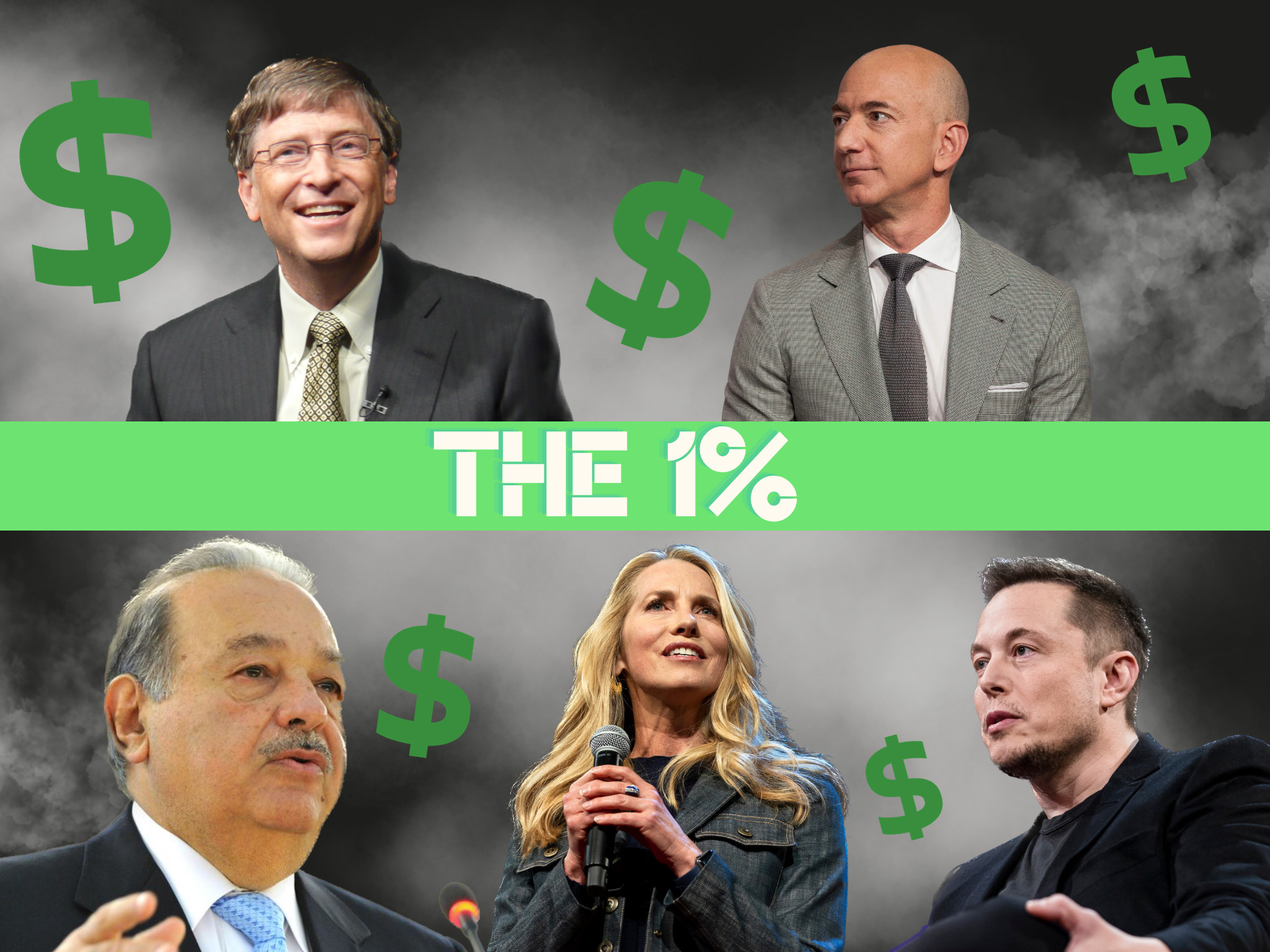Carbon Inequality: Top 10% Account For 50% of Global Emissions, Richest 1% Linked To 1.3 Million Climate Deaths
9 Mins Read
Ahead of COP28, a new climate inequality investigation, The Great Carbon Divide, assesses how the carbon emissions of the rich disproportionately affect lower-income and vulnerable populations. Plus, a UN report shows that current global emissions are on track for doomsday-level scenarios.
In the latest case of rich-people-things worsening the lives of the vulnerable, a new series of investigations has revealed the stark contrast between the climate impact of the world’s wealthiest and poorest.
The world’s richest 1% – you know, the Musks and the Slims and the Bezoses – are responsible for more carbon emissions than the poorest 66%, with vulnerable communities hit hard. How hard? Their emissions are enough to cause heat-related deaths of 1.3 million people in the coming decades.
The new investigation by Oxfam – called The Great Carbon Divide – assesses the causes and implications of carbon inequalities as well as the disproportionate impact of the mega-rich, termed “the polluter elite”. This group is made up of 77 million people (who make over $140,000 a year), who accounted for 16% of all carbon emissions in 2019.
The wealthiest 1%, meanwhile, emitted 5.9 billion tonnes of CO2 in 2019, and these have immense implications for low-income populations. The 1.3 million figure was calculated with a mortality cost formula – used by the US EPA too – of 226 excess deaths for every million tonnes of carbon.
More wealth, more emissions
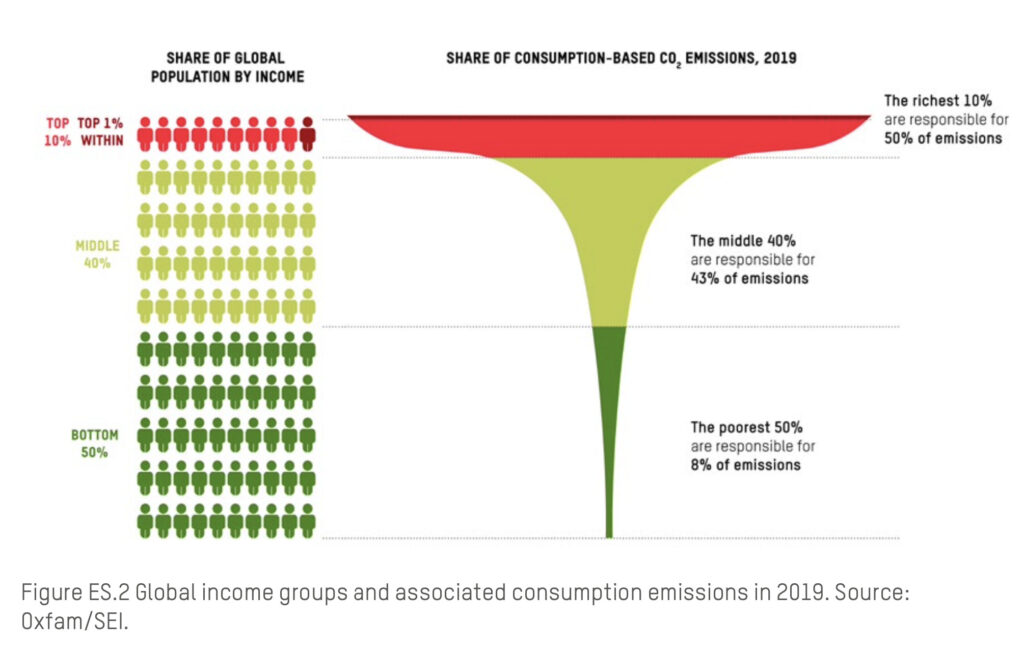
The Oxfam reports says that the wealth gap between countries doesn’t paint the full picture. While high-income countries (mostly in the Global North) were responsible for 40% of global consumption-based carbon emissions in 2019, low-income nations (mostly in the Global South) accounted for just 0.4%. But the key takeaway from the published research is the income inequality within countries.
While a majority of billionaires are overwhelmingly white, male and US- or Europe-based, the super-rich are increasingly being found in other parts of the world. This spells trouble for the climate – the carbon footprint of the 0.1% is 77 times higher than the rest of the population – owing to superyachts, private jets, mansions, space flights and doomsday bunkers, among other things – than the upper-level needed to limit global temperature rises to 1.5°C above pre-industrial levels.
Data shared with the Guardian revealed that 12 of the world’s richest billionaires account for almost 17 million tonnes of CO2 and CO2e annually. Using the mortality formula, that could cause over 3,800 extreme-heat-related deaths. This number is also equivalent to the annual energy emissions of 2.1 million homes or 3.8 million gas-powered cars.
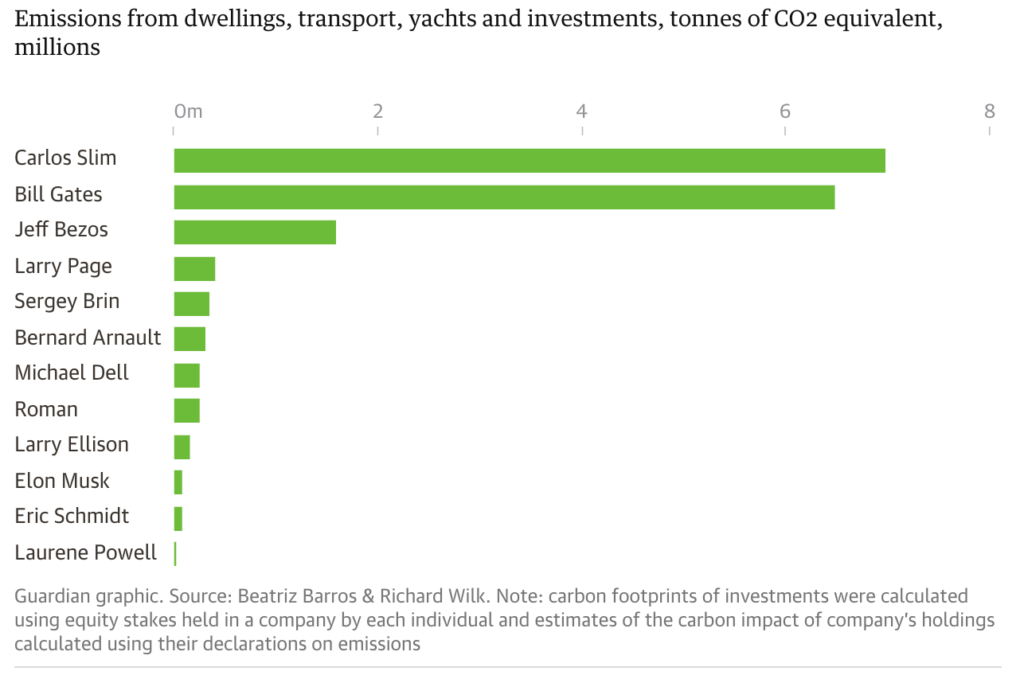
These 12 billionaires are Bill Gates, Elon Musk, Carlos Slim, Larry Page, Sergey Brin, Bernard Arnault, Michael Dell, Roman Abromovich, Larry Ellison, Eric Schmidt and Laurene Powell Jobs. “Billionaires generate obscene amounts of carbon pollution with their yachts and private jets – but this is dwarfed by the pollution caused by their investments,” said Oxfam International’s inequality policy adviser Alex Maitland. “Through the corporations they own, billionaires emit a million times more carbon than the average person. They tend to favour investments in heavily polluting industries, like fossil fuels.”
Emissions from the investments of 125 billionaires, meanwhile, averaged 3.1 million tonnes per capita – over a million times higher than the average emissions by the bottom 90% of the world’s population. And while these billionaires have been involved in social and environmental funds and philanthropic causes – like the Bezos Earth Fund and the Bill & Melinda Gates Foundation – their wealth provides them with a hefty influence in political circles.
“These people have an outsize political influence because of their enormous wealth, which they use to leverage local and national governments, gaining exemptions from taxes and privileges that allow them to pollute and to influence laws regulating pollution,” said Richard Wilk, one of the analysts behind the numbers. “If you look at them as entities, some of them are rivalling states in terms of their influence.”
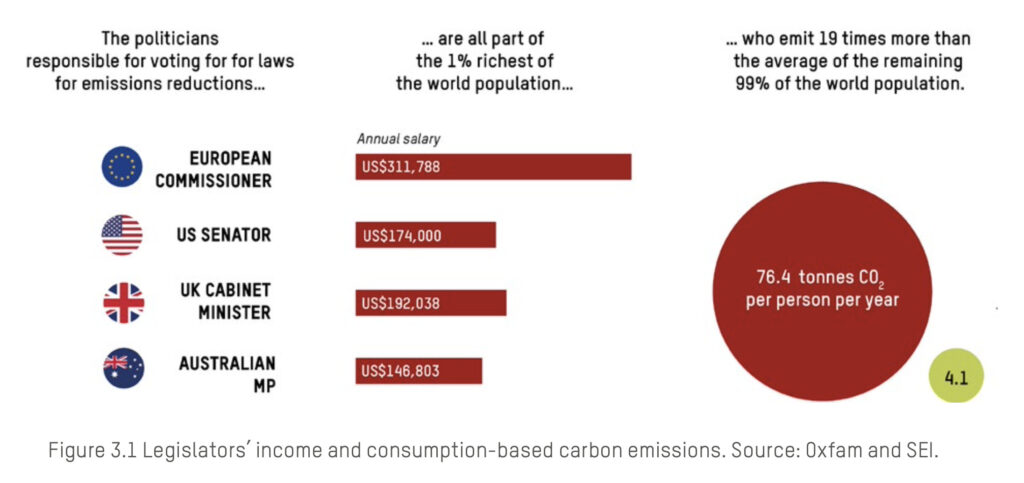
Speaking of politics, many legislators – who will dominate the upcoming UN COP28 summit in Dubai – are part of the 1% too. In the US, one in four Congress members own stocks in fossil fuel companies, for example. This is why Oxfam is calling for wealth taxes on the mega-rich, and windfall taxes on fossil fuel companies, which will alleviate the people worst affected, decrease inequality, and help transition to cleaner energy. A 60% tax on the incomes of the 1% would raise $6.4T a year and could cut emissions by 695 million tonnes, which is higher than the 2019 footprint of the UK.
The top 10% cause 40 times more emissions than bottom 10%
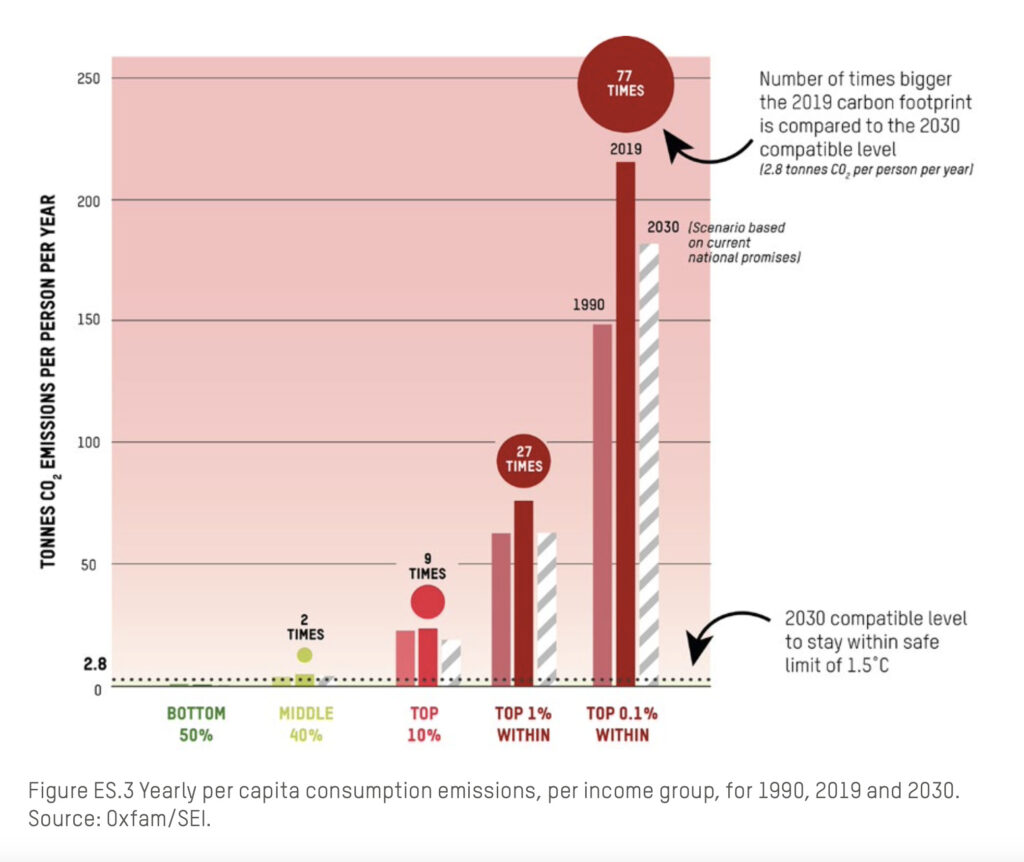
Data obtained by the Guardian also showed that the richest 10% in the world – most of the middle classes in developed countries that earn over $40,000 a year – cause up to 40 times more emissions than the poorest 10%. While the lifestyles of the 1% are subject to much more public scrutiny (and rightly so), these 10% are actually responsible for half of all global emissions.
This is across different countries, with the top 10% emitting as much as the bottom 50% (at the very least). According to the International Energy Agency, In the US, UK, EU and Japan, the energy-related carbon footprints of the richest 10% are 15 times higher than the poorest 10%, while in China, South Africa, Brazil and India, the former group accounts for 30-40 times more than the latter.
Transportation is a major emitter, contributing to a third of the 10%’s emissions in the US and Canada, while being 20-40 times higher than the emissions of the poorest 10% in the 12 countries analysed. There’s a marked country-by-country divide as well: the poorest 10% in the US still have a footprint bigger than 90% of the same group in India.
Additionally, the projected growth in millionaires – from 0.7% of the global population to 3.3% – would take accumulated emissions to 286 billion tonnes of carbon. This is about 70% of the emissions budget left in 2021 if global heating were to be kept to the 1.5°C limit.
How the vulnerable are affected
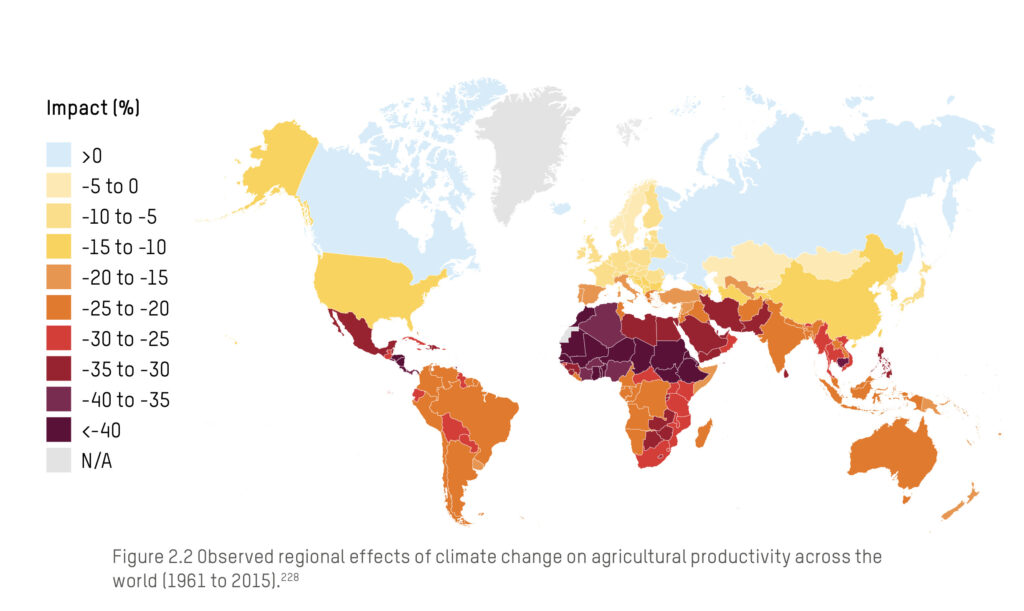
But while the rich become richer, it’s the vulnerable who are worst affected. “The world’s poorest communities, those who have done the least to cause climate change – those who are least able to respond and recover – are the ones who are suffering the worst consequences,” said Maitland. “This is unfair and immoral.”
We’ve already talked about the 1.3 million deaths that could be caused by the emissions of the richest 1%, and the Oxfam report also suggests their emissions would eliminate last year’s harvests of EU corn, US wheat, Bangladeshi rice and Chinese soya beans. In fact, it would take 1,500 years for someone in the bottom 99% to produce as many emissions as the richest 1% do in a single year. Imagine that!
It’s the marginalised communities – migrants, women, girls, Indigenous populations, and those who live in extreme poverty and/or live and work in extreme weather – that suffer most. These people are less likely to have savings and access to welfare, social protection or insurance schemes, and this makes their livelihoods more financially and physically susceptible to floods, drought, heatwaves and forest fires. According to the UN, 91% of all deaths related to extreme weather occur in developing countries.
“The super-rich are plundering and polluting the planet to the point of destruction and it is those who can least afford it who are paying the highest price,” said Chiara Liguori, senior climate justice policy advisor at Oxfam.
Our emissions are out of control
We’ve mentioned 1.5°C a couple of times in this piece – but it’s imperative to note that this may be an ill-advised ambition now, given the state of our GHG emissions. We have already begun breaching the 1.4°C range – and now, the UN has warned that we’re on course for 3°C warming above pre-industrial levels, based on current carbon reduction policies.
That’s double the current heating goal – and it will make for, in UN Secretary General António Guterres’ words, a “hellish” future. We’re already seeing widespread crop failures, massive flooding and droughts, and extreme temperatures, but we’re in for way worse if we actually do reach 3°C.
This is in line with a UNFCC report from last week, which found that national climate action plans to limit global temperature rises to 1.5°C above pre-industrial levels remain insufficient.
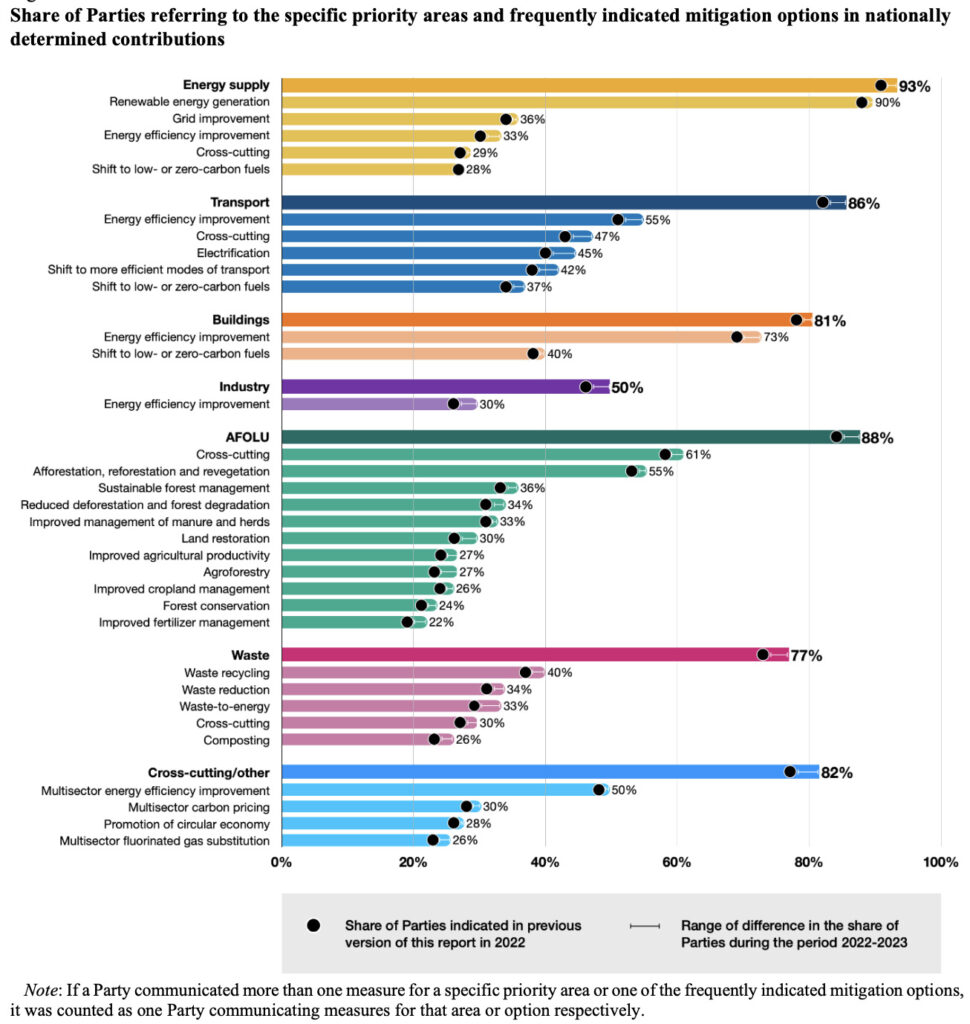
If developing countries receive the financial and technical aid they require to cut the amount of emissions they have promised, the temperature rise would reduce to 2.5°C, which is still catastrophic. To get back on the 1.5°C track, we need to remove 22 billion tonnes of carbon from the projected total in 2030 – that’s 42% of the world’s emissions, or equal to those of China, the US, India, Russia and Japan, the five worst polluters.
If all long-term net-zero pledges for around 2050 are met, even then, the temperature rises would be at 2°C. In September, a study published in the Energies journal suggested that a 2°C rise by 2100 could lead to a billion deaths.
“There is no person or economy left on the planet untouched by climate change, so we need to stop setting unwanted records on emissions, temperature and extreme weather,” said Inger Andersen, executive director of the UN Environment Programme.
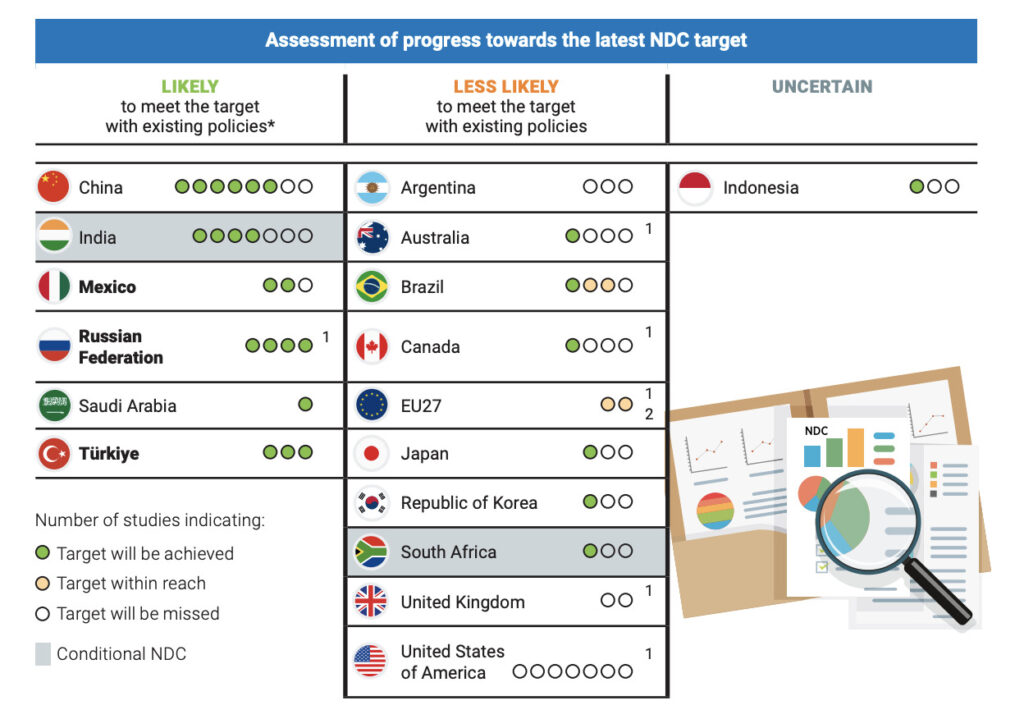
“Present trends are racing our planet down a dead-end 3°C temperature rise. This is a failure of leadership, a betrayal of the vulnerable, and a massive missed opportunity,” said Guterres. But he added: “We know it is still possible to make the 1.5-degree limit a reality. It requires tearing out the poisoned root of the climate crisis: fossil fuels.
“Leaders must drastically up their game, now, with record ambition, record action, and record emissions reductions. No more greenwashing. No more foot-dragging.”
But despite the UN finally focusing on food at this year’s COP28, there was much less mention of food and agriculture, which account for a third of all emissions. The Energies journal report revealed that even if we stop all emissions from non-food sectors (energy and industry), food emissions alone will surpass the 1.5°C carbon budget.
It pains to state things so acutely: this year’s climate summit is crucial to the planet’s future- countries must agree on critical emissions reduction targets or else there really may be no turning back.


